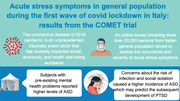- Record: found
- Abstract: found
- Article: found
Acute stress symptoms in general population during the first wave of COVID lockdown in Italy: Results from the COMET trial

Read this article at
Abstract
Background
The coronavirus disease of 2019 (COVID‐19) pandemic is an unprecedented traumatic event that has severely impacted social, economic, and health well‐being worldwide. The COvid Mental hEalth Trial was specifically designed to evaluate the impact of the COVID‐19 pandemic and its containment measures on the mental health of the Italian general population in terms of COVID‐19‐related acute stress disorder (ASD) symptoms.
Methods
The present cross‐sectional study is based on an online survey carried out in the period March–May 2020. Italian general adult population was invited to compile an anonymous survey, which included the severity of acute stress symptoms scale/National Stressful Events Survey Short Scale to investigate the occurrence and severity of ASD symptoms.
Results
The final sample consisted of 20,720 participants. During the lockdown, subjects with pre‐existing mental health problems reported a statistically significant higher risk of acute post‐traumatic symptoms compared to the general population ( B: 2.57; 95% CI:2.04–3.09; p < .0001) and health care professionals ( B: .37; 95% CI: .02–0.72; p < .05). According to multivariate regression models, the levels of acute post‐traumatic symptoms ( p < .0001) were higher in younger and female respondents. Social isolation and sleep disorder/insomnia represented positive predictors of acute stress ( B = 3.32, 95% CI = 3.08–3.57).
Abstract
In our paper, we analyzed the impact of COVID‐19 pandemic on the general population in Italy, during the first phase of the lockdown. In particular, data were collected from more than 20,000 persons from the general population using the severity of acute stress symptoms scale, together with several other validated assessment tools.
Related collections
Most cited references92
- Record: found
- Abstract: not found
- Book: not found
Diagnostic and Statistical Manual of Mental Disorders
- Record: found
- Abstract: found
- Article: not found
Development of a new resilience scale: the Connor-Davidson Resilience Scale (CD-RISC).
- Record: found
- Abstract: found
- Article: not found
